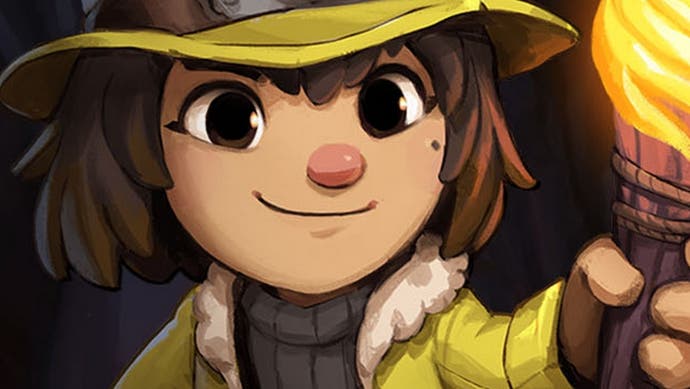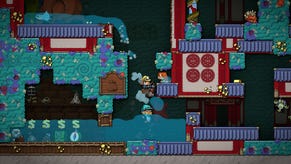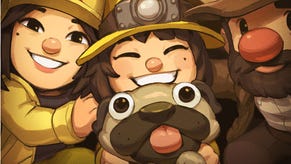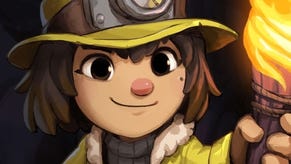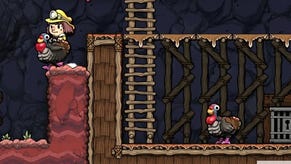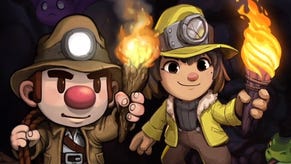Spelunky 2 review - the depths beckon
To the moon!
A friend of mine recently told me what it's like to fall off a skateboard in your forties. Listen: it's an event. You remember it. Oof! And you remember what follows. Woe so thick and painful it is almost mineral. Woe that casts a shadow when you breathe it all out. The fall is quick but the recovery takes time. You ease up off the gritty floor, collect your glasses and the things that were in your pockets, and then you find a spot to sit and you sit for a long while. What are you doing for this long while? You are preparing. You are preparing to start living again, preparing to face the awful prospect of yet more life. Falling off a skateboard in your forties makes you feel like one of the sagging wretches Rembrandt was so good at painting.
From one master to another: Spelunky does this too. The playthrough - often a long one, which in Spelunky speak means, oooh, all of six minutes - that seemed so promising and ended so suddenly, with such brisk and all-consuming calamity. You put down the pad and blink and then you find a quiet corner, hopefully under the speckled shadows of a looming monstera. You sit and let the room tick and creak and settle, and you let time flow around you. Because this is something you need to recover from. You become a Rembrandt. It will take more than minutes to return from this. It can take hours.
There's a lot of stuff in Spelunky 2 - in many ways it's A Lot of Stuff: The Video Game - yet one of my favourite things in all of it - one of the things most likely to create the echoing trembles of the Rembrandt Run - is a simple stretch of corridor. Sometimes, while exploring the very first levels of this procedural platformer, a bold attempt to sequelize one of the very few genuinely Tetris Tier games out there, you will come up across this simple stretch of corridor, and you will walk down it and regardless of how good your chances were a second ago, you will meet something that kills you pretty swiftly. Not because of any trap or any gimmick, but because you hadn't prepared yourself for the specific procedural nightmare that was coming your way. The spider-and-bats knuckleball that beans you. The moles - the sodding moles - who have interacted badly with a spiny lizard. The turkey that tried to help but didn't help. The corridor is nothing special, it's just a little too low to allow you to deal with something at speed. Or if you're second-guessing yourself. Or if you're second-guessing yourself at speed.
Interesting, those deaths. Spelunky makes death (video game death, not death death) incredibly interesting. I tend to think of Spelunky as a means of teaching virtuous behaviour as much as it is a video game. Granted, this makes it sound shiiiiiit. But in teaching virtues it also teaches you about all the vices. It has to. Generally you die in Spelunky because you're greedy or because you aren't paying attention. You die for the same reasons that some people get caught out for tax fraud and others end up rear-ending a bus filled with nuns. Some of these flaws are in you; I mean that the potentials for these flaws are in you. Spelunky 2 has so many converging tricks to draw them out that it can wing it on occasion. It can stage its best stuff in... a simple stretch of corridor with a lowish ceiling. Even then, the ceiling's not that low. It's not ostentatious or anything.
I am still dying a lot, up on the moon where Spelunky 2 is set, generally playing as Ana, the daughter of the Spelunker from the first game. It comes in waves, in stages, this dying I am doing. The unforeseen deaths. The experimental, what-does-this-thing-do death. The blasé deaths (my speciality). The deeply unfair deaths that are still - this is Spelunky - the kind of thing you can trace back to a source and thus come to understand the varied steps that lead to your downfall.
If you're not coming from Spelunky 1, all you need to know is that this is a brilliant 2D platforming game about exploring deadly caves, and the game jumbles the layouts every time you play, while keeping certain elements the same. It's like getting to know an inventive, voluble liar, but one who has a recurring nightmare that won't entirely leave their heads and thus stains all lies, all fabulous flights, with the same cherished, feared elements. If you are coming from Spelunky 1 you will be right at home: same sense of character weight, same controls, same basic starting gadgets in the form of ropes and bombs and a whip. Same goal: move downwards from level to level. Same bats. Same spiders. Same snakes. So much is the same.
And then you start to die. You start to die an awful lot. Because in amongst the stuff that's the same is stuff that is wildly, aggressively new. And yet! Even then it still meshes beautifully with Spelunky's existing clockwork. And by beautifully I mean vindictively. And by vindictively I mean that I often have to turn Spelunky 2 off to sulk for an entire day while I think about my place in the world. This game is a beast.
Let us talk of some of the new things. Reader, I am making a list. I am checking it twice. And at the top of it, this list reads: moles can do one. Moles erupt from the ground, which means that the ground itself, at least a certain type of ground, is no longer safe - it must be modeled in the mind along with all the other emergent horrors. And actually, gathered members of the press, it's not just moles. It turns out that the new four-way spike-traps in the jungles can do one as well, taking something awful and making it worse. How much worse? Four ways worse. A fork that is all tines and no handle! Screw that. The spiny lizards can do one. Are you a lizard or a wrecking ball? Both?! The witch doctors can really do one, conjuring deadly skulls that can pass through walls. Speaking of which (of witch?), the new variation on the mechanism that triggers the ghost can do a ghostly one. And... And... None of this is criticism, of course. In Spelunky part of me lives for the things that can do one.
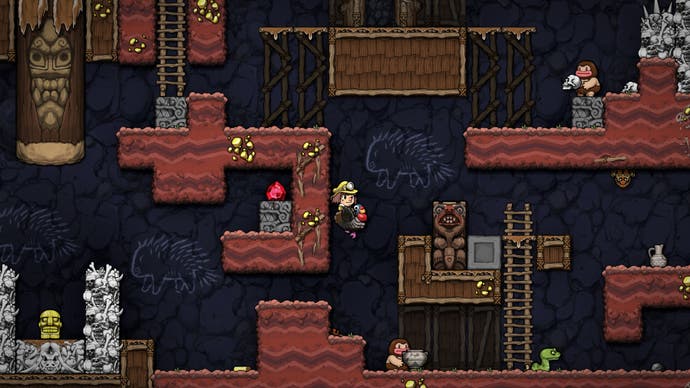
This is just the surface. But the surface can still kill you 300 hours in. And it will. Then there are the weirder elements. I like to read Spelunky as a highly personal, even autobiographical work in which many of the stranger details would make sense if I only had more context - if I actually knew Derek Yu, the game's creator, for example, and understood what he had been through. It's fun to approach things this way. What did Wall-E ever do to you, Derek Yu? And flame-throwing ladybugs that ride up and down on chains? Dude: what happened?
Both of those examples come from just one of Spelunky's new levels. It's a level that - tell me if this is familiar - at first seems impossible and then slowly starts to become manageable, until it is filled with rich promise while still being, intermittently, impossible. The first Spelunky had a delicate design here - a design that existed not despite the procedural scrambling but because of it. The mines were always where you got your bearings. The jungles were a big test and a big leap, and then the ice caverns beyond them were a bit of relaxation prior to - oh cripes - the temple.
Here there's something similar, except at the end of each environment you get a choice - which place to go to next? So after the starter Mines-alike, you get a tricky, awful place that is somewhat familiar or a place I absolutely love, which is less familiar and merely somewhat awful. Tricky! Onwards and outwards, the choices pile up. Familiar, unfamiliar, sheer horror. One of the levels is so beautiful I might actually bust out crying.
A big thing has been made of the fact that levels have two sides, as it were - you can go through a door in Mines and be behind the scenes, in a separate room and able to see other separate rooms buried behind the bedrock. This is a huge change! And it leads to some very clever stuff! But in your first 10 or so hours, it matters much less than the garden of branching paths that makes up the course of the campaign as it exists when you're still learning the basics.
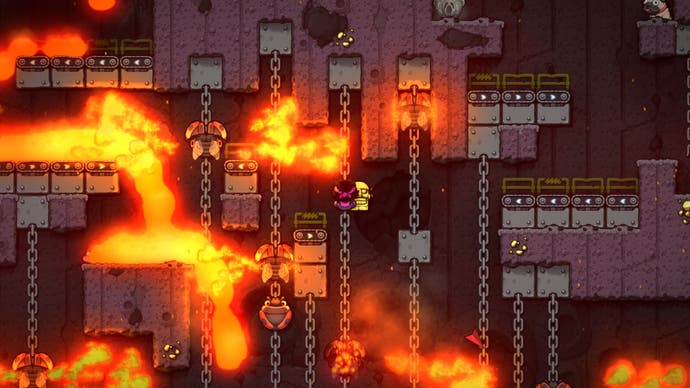
I say that because, once you're no longer learning the basics, you'll discover that the campaign is a lot more flexible now. One of my big revelations 200 hours into the first Spelunky is that the game isn't difficult to play so much as it's difficult to learn how to think about. There's this place in the first Spelunky called the City of Gold. It's difficult to get to - a bit of a secret - until you learn how to think about how to get there and then it becomes possible. The game becomes a big shopping list and you just have to focus on the right items. This is how Spelunky likes to bed in its secrets. There will be little oddities scattered throughout many levels, and they are nodes, really, and you just need to work out which of them join up. This carries over. For example, in Spelunky 2 an item in world one - this is as much of a spoiler as I can bring myself to reveal - allows you to trigger... something... in one of the possible world twos. But only one of them? And then? What then? And what of the other world two?
To put it another way, I've come to feel there are two main ways to approach Spelunky. The first is that you follow its will and simply react, following the contours of what the game has decided is possible today. It's the "when life gives you jetpacks" approach. The "play the hand you're dealt and love it" approach. The second approach is to fight against the will of the game and impose your own. Three caves in pitch darkness, no bombs left and I've started to smell weird, but I am going to make it to the City of Gold. I feel like Spelunky 2 has been designed with a deep knowledge of these two approaches, and a desire to support both with great generosity.
The depths beckon. The world spins. The sheer complexity of the thing, its possibilities foreseen and unforeseen have me reaching for the co-codamol. Yes, Spelunky has always had this stuff, these buried paths that go deeper than the procedural jumbling, a sort of thieves' network that only allows the initiated or the fortuitously clumsy. And yes, Spelunky 2 takes this and expands on it in terrifying ways. In truth I am still learning a lot of these ways, which means that I am playing with a notebook and writing down ideas. What's behind BLANK? What's beneath BLANK? If I get BLANK can I use it to BLANK? How do I pull out BLANK?
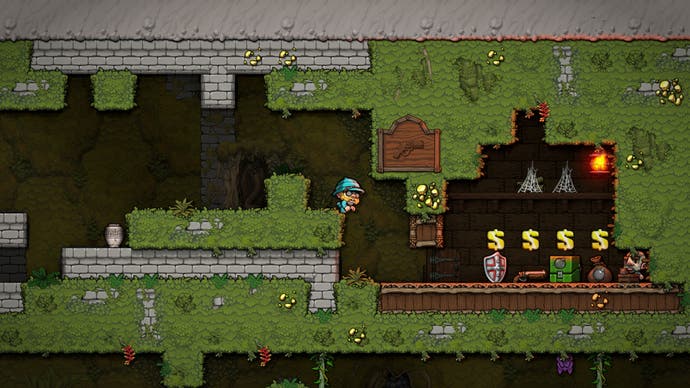
All of which makes Spelunky sound confusing, but that's the game trying to trick you to play five seconds into the future again - and if you do that you will often die. What dazzles me is how vividly Spelunky 2 is still a game of the moment. Take this: there is so much greatness emerging from the simple decision that you're going down and not up in Spelunky. It means that gravity can take some of the effort out, and can also add its own brilliantly Newtonian timing to the comedy that erupts when things go wrong. It means that levels can rain chaos from above and that rock ledges can crumble and take you on terrifying shortcuts. You can't argue with gravity. It's such a good basis for things.
Adding to this is a new focus on material physics such as lava and water. In the first game these were present but somewhat inert. If you blew up their containers they wouldn't do much. Here if you blow a wall in a lake, the lake comes out to say hello. If you destroy the barrier holding back lava it slops towards you and causes so much trouble I don't even want to think about it. Gravity again! I will be part of the way through a level, just spelunking along, and lava from above will rain down and end my day. And gloriously. I cannot begrudge it.
Spelunky's always seemed alive - I love the way its levels start to play itself the moment you appear - but stuff like lava and water really drives this point home. Those moles make the ground alive! Then there are mounts, which need to be bedded in before they fall in love with you. There are new kinds of vendors and visitors, none of whom you want to upset. Some of Spelunky 2's levels are so alive that they seem overwhelmingly unstable the first few times you reach them, as if you'd mixed everything from under the kitchen sink together in a jug and lit a sparkler for good measure. They're not, of course. They're just the point at which dozens of systems converge. Dozens more than in Spelunky 1. This is that rare sequel that really evolves its own personality through the careful addition of more stuff - A Lot of Stuff: The Video Game.
And it is carefully added. Any sequel to Spelunky must also be a game about Spelunky - a response to how people played the first game and how the approaches varied and eventually ossified. As such, lots of the changes tie into the same things. There are lots of things to keep you moving, to encourage you to tackle things on the fly, thinking while acting. There are lots of things that allow for chain reactions, often explosive, and that ties into speed too, doesn't it?
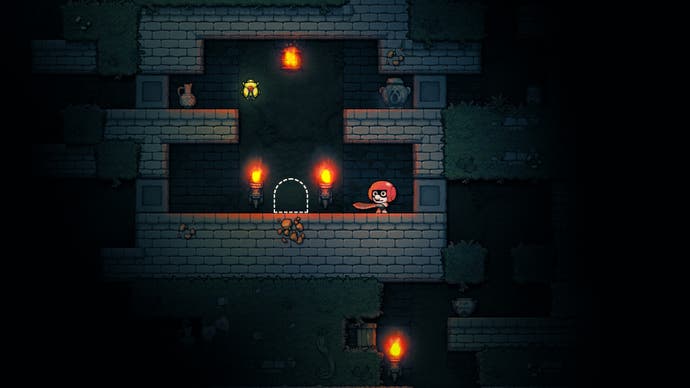
Those chains! The brisk business of action and reaction is so specific in its pace here that it took me a while to remember what it reminded me of. It reminds me of dialogue. Not just dialogue, but particularly the zingy chip-and-charge dialogue of His Girl Friday and those other screwball charmers where everyone's a smart alec journalist in a busy newsroom and you can almost sense the tennis whites beneath their suits, and where the only thing that clatters faster than the typewriters is the clever stuff that they all have to say to each other. Brisk? It's positively nifty! Backhand!
Throw in online multiplayer, deathmatch, the Daily Challenge, Seeded Runs (which are going to be huge). Throw in a focus on enemies that feel like mini-bosses, status effects, all sorts of things I am yet to get my head around. Throw in a growing camp back home with all the characters you've unlocked and throw in that dense network of secrets that lead to new secrets that lead to whole chains of possible consequence and adventure stretching taut strings between this expansive, terrifying world. A cat's cradle of dark, audacious brilliance. All of it as risky as it is rewarding: mounts that may kill you in the brief seconds before you tame them, AI allies - or real friends - who might blow you to pieces while trying to help, gadgets new and old that might make a run or end it.
And that central surprise - such chaos co-existing with such precision. Whenever I think about the first Spelunky and how carefully it's made, how much sheer thought and imagination about the players who play it has gone into it, I always think about two things. The first is that way an arrow loosed from a trap will send a ripple up and down any rope it passes - in this place every action is noticed by the world around it.
The second is that there are never any shops in the very first level, because if there were shops you might be tempted to reload and reload until you got the item you wanted in that shop. It's not just that Spelunky understands the ways we think. It's not just that it understands the powers of its most complex systems and the way they can create unintentional shadow systems in the players' minds. No. It's that it knows that if you get through 1-1 you will be sufficiently committed to your current run to never think about restarting to get a better shop. It knows what it is and how powerful it is.
Deep breath. Thinking about 1-1 in the original Spelunky makes me feel very lucky to be encountering the sequel right now, at the start of it all. The first Spelunky is a game of secrets, which means that for the last decade it's been a game without secrets - everything about this world is known and categorised. But a sequel? It's lovely to stand on the windy precipice again, knowing, even after 20 hours, 30 hours, that you cannot yet know even a third of the things that await. It's the difference between bingeing a Netflix series and the exquisite, intoxicating agony of waiting a week for the next episode on BBC 2. Intoxicating agony? That sounds like Spelunky. What an astonishing mechanism this is.
